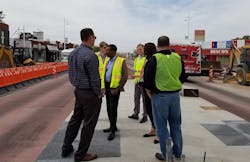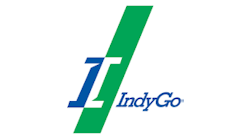In 2012, when Albuquerque, New Mexico was exploring the idea of operating a Bus Rapid Transit system, its officials visited Cleveland to ride and observe that city’s “HealthLine” Bus Rapid Transit system. Now that Albuquerque is building its BRT, named Albuquerque Rapid Transit, it is getting visits from other municipalities around the country interested in building their own BRT systems.
That’s why three representatives of the Indianapolis Public Transportation Corporation came to Albuquerque during early April; to see what the building of Albuquerque Rapid Transit has entailed and how lessons learned in Albuquerque might apply to IndyGo’s planned “Red Line” Bus Rapid Transit Project.
Justin Stuehrenberg, project manager for the IndyGo Red Line, John Marron, the Red Line’s Deputy Project Manager and Kevin Campbell, manager for HNTB (the Red Line contractor) toured Albuquerque’s ART project on April 11 and 12. Their two days were spent touring the construction corridor, meeting with Albuquerque Mayor Richard J. Berry, attending project construction meetings for different segments of the corridor, attending the weekly ART Public Outreach meeting, as well as meetings about startup plans, training, operations and maintenance.
Why Albuquerque? “Because this rapid project is very similar to the one we’re about to start (construction) on,” said Stuehrenberg. “The center dedicated lanes, raised platform stations and relatively narrow streets. Just a very similar project and we wanted to get lessons learned from you.”
Other similarities both projects share: both have committed to using electric buses for their routes, serving some high-density commercial areas. Both systems will also run part of their routes in non-dedicated lanes toward the end of the route, as well as through a mix of high and low-density areas.
IndyGo’s Red line will be a fast, frequent and comfortable way to provide transit to the states’ two largest employment concentrations in Downtown Indianapolis and along U.S. Highway 31 north to Carmel, as well as the state’s largest hospital and four major higher education institutions.
The three visitors acknowledged that because the Albuquerque Rapid Transit project has the potential to be a highly-rated BRT project by the Institute for Transportation and Development Policy (ITDP), getting a first-hand look at ART was imperative for their planning.
“One of the takeaways that I have is just a lot of the processes that (Albuquerque) is going through, whether it be the way that you coordinate the construction team on the segments; whether it’d be the public outreach team leading the way,” said Kevin Campbell, the construction manager for the Red Line’s contractor. “So, I think there’s just a lot that we can learn and glean from the processes that (Albuquerque) has established and I think that’ll help inform our work.”
Just as Albuquerque’s visit to Cleveland helped city officials gather ideas on how to establish a Bus Rapid Transit system, so do Indianapolis’ representatives hope their Albuquerque visit will help them. Especially important is the way different city departments have worked together on the project.
“I’d say the other part that’s impressive is the public sector-side cooperation; that integration between the city departments is vital. We’re building upon that and trying to make that happen in Indianapolis as well,” said John Marron, deputy project manager for the Red Line. “But seeing it here on the ground just made it clear to me how important that is that you have all those public stakeholders pulling together.”
Construction on the Red Line is scheduled to begin this year, with the first buses scheduled to operate by 2018. Albuquerque Rapid Transit is scheduled to open this fall.




